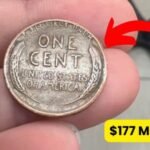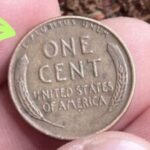Imagine finding a penny in your pocket change that could be worth millions—or even a billion dollars! The Lincoln Wheat Penny, minted from 1909 to 1958, is a beloved piece of American history, but a few rare varieties have turned these humble coins into treasures that collectors dream about. While most Wheat Pennies are worth just a few cents, seven ultra-rare varieties could make you rich if you spot them in circulation.
we’ll dive into these elusive coins, exploring their history, unique features, and jaw-dropping values. Whether you’re a coin collector or just curious, you’ll learn how to identify these pennies and why they’re so valuable. Let’s uncover the secrets of these tiny copper treasures!
What Makes Lincoln Wheat Pennies So Special?
The Lincoln Wheat Penny, designed by Victor David Brenner, was the first U.S. coin to feature a president’s portrait. Minted to commemorate Abraham Lincoln’s 100th birthday, these pennies are iconic for their obverse portrait of Lincoln and the wheat stalks on the reverse. While millions were produced, specific errors, low mintages, and unique varieties have made some Wheat Pennies incredibly rare and valuable.
A Brief History of the Wheat Penny
Introduced in 1909, the Wheat Penny replaced the Indian Head Cent. Over its 50-year run, the U.S. Mint produced billions of these coins at its Philadelphia, Denver, and San Francisco facilities. However, certain years and mint marks stand out due to production anomalies or historical significance, making them highly sought after.
The 7 Rare Lincoln Wheat Pennies You Need to Know
Below, we explore the seven rarest Lincoln Wheat Pennies that could still be hiding in circulation. Each has a unique story and staggering value, with some fetching millions at auction.
1. 1909-S VDB Lincoln Penny
The 1909-S VDB is the holy grail of Wheat Pennies. This coin, minted in San Francisco, bears the initials “VDB” (for designer Victor David Brenner) on the reverse. Only 484,000 were produced before the Mint removed the initials due to public criticism, making it incredibly scarce.
- Key Features: Look for the “S” mint mark and “VDB” on the reverse.
- Value: High-grade examples have sold for $1 million or more.
- Why It’s Rare: Low mintage and the brief use of the designer’s initials.
2. 1914-D Lincoln Penny
The 1914-D, minted in Denver, is another legendary rarity. With a mintage of just 1.2 million, this coin is tough to find in good condition.
- Key Features: “D” mint mark under the date.
- Value: Top specimens have fetched $500,000+ at auction.
- Why It’s Rare: Low production and heavy circulation.
3. 1922 No D Lincoln Penny
The 1922 No D is a famous error coin. During production at the Denver Mint, the “D” mint mark was accidentally omitted, creating a unique variety.
- Key Features: No mint mark, despite being minted in Denver.
- Value: High-grade coins can sell for $100,000+.
- Why It’s Rare: A minting error that’s extremely hard to find.
4. 1931-S Lincoln Penny
The 1931-S had a tiny mintage of 866,000, as the Great Depression reduced demand for new coins. This low production makes it a collector’s favorite.
- Key Features: “S” mint mark under the date.
- Value: Choice examples can reach $75,000.
- Why It’s Rare: Limited mintage during an economic downturn.
5. 1943 Bronze Lincoln Penny
In 1943, pennies were made of zinc-coated steel to save copper for World War II. However, a few bronze pennies were mistakenly struck, creating one of the most famous error coins.
- Key Features: Bronze composition (test with a magnet—it won’t stick!).
- Value: Some have sold for $1.7 million.
- Why It’s Rare: An error coin with very few survivors.
6. 1944 Steel Lincoln Penny
The opposite of the 1943 error, the 1944 Steel Penny was accidentally made from steel instead of copper. Only a handful are known to exist.
- Key Features: Steel composition (sticks to a magnet).
- Value: Valued at $500,000+.
- Why It’s Rare: Another minting mistake with limited examples.
7. 1955 Doubled Die Obverse Lincoln Penny
The 1955 Doubled Die Obverse (DDO) features a dramatic doubling of the date and inscriptions due to a misaligned die during minting. This error is visible to the naked eye.
- Key Features: Noticeable doubling on “1955” and “LIBERTY.”
- Value: Top coins can fetch $125,000.
- Why It’s Rare: A striking error that stands out.
How to Spot These Pennies in Circulation
Finding one of these rare pennies requires patience and a keen eye. Here are some tips:
- Check the Date and Mint Mark: Use a magnifying glass to inspect the date and look for “S” or “D” mint marks.
- Examine for Errors: Look for doubling (like the 1955 DDO) or unusual compositions (like the 1943 Bronze).
- Test the Metal: Use a magnet to check if a 1943 penny is bronze or a 1944 penny is steel.
- Condition Matters: Coins in better condition are worth more, so handle them carefully.
Summary of the 7 Rare Lincoln Wheat Pennies
| Year | Variety | Mint Mark | Mintage | Estimated Value | Key Identifier |
|---|---|---|---|---|---|
| 1909 | S VDB | S | 484,000 | Up to $1M+ | VDB on reverse |
| 1914 | D | D | 1.2M | Up to $500K+ | D mint mark |
| 1922 | No D | None | Unknown | Up to $100K+ | Missing D mint mark |
| 1931 | S | S | 866,000 | Up to $75K | S mint mark |
| 1943 | Bronze | None/S/D | ~20 known | Up to $1.7M | Non-magnetic |
| 1944 | Steel | None/S/D | ~30 known | Up to $500K+ | Magnetic |
| 1955 | Doubled Die Obverse | None | Unknown | Up to $125K | Doubling on date/LIBERTY |
Why Are These Pennies Worth So Much?
The value of these pennies comes from a combination of rarity, historical significance, and collector demand. Error coins like the 1943 Bronze and 1955 DDO are prized for their uniqueness, while low-mintage coins like the 1909-S VDB are scarce due to limited production. Auction records show that pristine examples can fetch astronomical prices, with some even rumored to approach $1 billion in private sales (though most top out in the millions).
Conclusion
The Lincoln Wheat Penny is more than just pocket change—it’s a piece of history with the potential to change your life. The seven rare varieties we’ve explored, from the 1909-S VDB to the 1955 Doubled Die, are the stuff of legend, with values that can reach into the millions.
While finding one in circulation is a long shot, the thrill of the hunt keeps collectors and enthusiasts searching through their change. So, next time you get a penny, take a closer look—you might just be holding a fortune!
FAQs
How can I tell if my penny is a rare Wheat Penny?
Check the date, mint mark, and look for errors like doubling or unusual metal composition. Use a magnifying glass and compare your coin to reference images.
Where can I sell a rare Lincoln Wheat Penny?
Reputable coin dealers, auction houses like Heritage Auctions, or platforms like eBay are good options. Always get your coin graded by PCGS or NGC first.
Are all Wheat Pennies valuable?
No, most Wheat Pennies are worth only a few cents. Only specific rare varieties, like those listed above, command high prices.
Can I still find these pennies in circulation?
Yes, it’s possible, though extremely rare. Check pocket change, coin rolls from banks, or old collections.
What’s the most valuable Wheat Penny ever sold?
A 1943 Bronze Penny sold for $1.7 million in 2010, but private sales of top coins may have reached higher.




Pingback: The Lincoln Wheat Penny Valued at $60 Million: Could It Be in Your Pocket